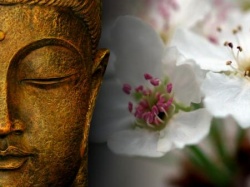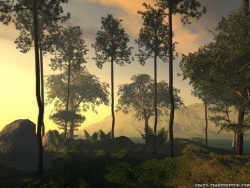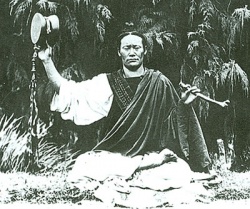The Post-mahAyAnic Character of the Lotus Sutra and its Principle
by Shin’ichi Tsuda
Within the complete scope of the historical development of Buddhist thought, in contrast to the MahAyAnic systems of the AXTasAhasrikA-prajJApAramitA [ASPP] and the GaNDavyUha [GV] that preceded it, the Lotus Sutra [SP] is duly defined as post-mahAyAnic (mahAyAnottara in Sanskrit). Such a definition is due to the fact that, at the stage of the Lotus Sutra, the Buddha revealed his true nature as the live, God-like TathAgata, freeing himself from the idealistic characterization in the preceding MahAyAnic systems. Through its presupposition of SAkyamuni's “fulfillment of the vow" to make all living beings attain buddhahood, the Lotus Sutra first, if not fully qualified, provides us with the “indicative” half of “the dialectic of human existence of the original enlightenment” (i.e.,"you are in yourself the TathAgata"), then leads us to succeeding systems of thought through the concealed latter “imperative” half of the dialectic (i.e., “still, you should by yourself become the TathAgata”) and, ultimately, to the final level of a religio-philosopy.
The great disaster of earthquake and tsunami that struck the Tohoku district of Japan on the 11th of March this year made me change the plan of this presentation from a scholastic argument to distinguishing the post-mahAyAnic character of the Lotus Sutra from the mahAyAnic character of the AXTasAhasrikA-prajJApAramitA [ASPP] and the GaNDavyUha-sUtra [GV] to descriptions of the evolutions of the theories of the TathAgatagarbha system which necessarily lead us to the thought of the “open-system” or the thought of PuruXa - its essence being the idea to understand the Nietzsche's notion of Notwendigkeit (destiny) as the turning (Wende) of difficulty (Not) which is actually necessitated for the people of the district that suffered fatally from the disaster. I define the Lotus Sutra [SP] as a scripture of the post-mahAyAnic (mahAyAnottara) Buddism in the total image of the historical development of Buddhism. Post-mahAyanic Buddism is composed of two systems in my notion, i.e., the system of Lotus Sutra and the system of the tathAgatagarbha theory. 12
The Lotus Sutra is the system of self-information of the presence of the TathAgata of dharmakAya to the world; and the systems of the tathAgatagarbha theories are the logia of argument about the logia of dharma-kAya, the cosmos-pervading existence of the God-like TathAgata.
The systems composing the history of Buddhism show their own special features on the common framework of the Schema of the two-worlds theory of the Buddhist view of the world, the celestial world of nirvANa or the dharma-kAya of the cosmos-pervading TathAgata, the world A transcendentally corresponding with the terrestrial world of living beings, the world B.(Fig.1)
I use the following terms to limit the concepts of these two worlds: dharma of neuter singular (dh. n. sg.) = the world itself. dharma of feminine singular (dh. f. sg.) = the essence of the existentiality of the world dharma of masculine plural (dh. m. pl.) = the individual existences constituting the contents of the world. (Fig.2)
The dharma of neuter singular assumes the bipolar structure of dh. f. sg. and dh. m. pl., the basis and the surface appearances of the world respectively. The dharma of feminine singular assumes the bipolar structure of avidyA (the substance of the world B) and vidyA (the substance of the world A). In the mahAyAnic system, the essence of dh. m. pl. composing the world A of ASPP is indicated with the term puNya-kriyA-vastu (facts as metrical deeds); and in the case of GV, the world A is expressed with the compound word Samantabhadra-caryAmaNdala, the whole of the meritorious deeds accomplished or accumulated by the Great Bodhisattva Samantabhadra.
In these two systems of ASPP and GV, the ideal world A itself appears instantaneously to a certain person as well as to all the persons presented in the image of the world when that person accepts a certain Idee of the deeds of Samantabhadra Bodhisattva as his own ideal and (Fig.3) performs it actually, and is kept existing through his continuation of doing the deed incessantly. (Fig.4)
In the “trace teaching”
(迹門)
of the Lotus Sutra, all the people present in the world B are 13
announced to have been buddhas in its mythological setting of ganjOju (願成就)
as the vow
of SAkyamuni Buddha to make all the people become buddhas has been realized since he attained his enlightenment some forty years ago at GayA. However, they are buddhas of human size as is suggested in the verse 60 of the Skillful Means Chapter: evaM ca cintemy ahu SAriputra
kathaM nu evaM bhavi sarvasattvAH /
dvAtriMSatIlakXaNarUpadhAriNaH
svayaMprabhA lokavidU svayaMbhUH //60//
“At the time, O SAriputra, I wondered how I could make all the people be as perfect buddhas ---- having bodies equipped with the thirty-two characteristic marks, being themselves resplendent, being knowers of the world, being born of themselves (60).” (Fig.5) In the “original teaching”
(本門)
, however, the Buddha SAkyamuni emerges in the text (ch.16, the Chapter of the Duration of the Life) as the cosmos-pervading TathAgata of dharma-kAya presenting his whole existence in the world B, and at the same time, to each living being existing in the world in the same manner, i.e., with his whole existences, respectively (tatrApi cAtmAnam adhiXThahAmi sarvAMS ca sattvAna tathaiva cAham, XVI,v. 4ab, KN.323.13).
Here we find that the complete figure of the world-view of post-mahAyAnic Buddhism appeared, and that the following systems of the tathAgatagarbha theory make themselves emerge within the framework shown in the “original teaching” of SP (Fig.6). The image of the tathAgatagarbha theory can be limited within the figure composed with the quotations from the tathAgatagarbha-sUtra [[TGS], the SrImAlA-sUtra [SM] and the AnUnatvApUrNatvanirdeSa-parivarta [AAN] found in the Ratnagotravi bhAga MahAyAnottaratantra-SAstra [RGV].
I at one time expressed my image of the formation of the tathAgatagarbha theory with the simile of a peapod (Fig.), in which the four peas TGS, SM, an anonymous text, and AAN are contained in
order; afterwards however, I withdrew the idea as I was taught the fact that the quotation from the anonymous text quoted in RGV has been identified 14
by Dr. E. Zimmermann with the corresponding passage of TGS existent in the Tibetan TripiTaka. The quotation from the “anonymous text” found in RGV goes as follows: tatra ca sattve sattve tathAgatadhAtur utpanno garbhagataH saMvidyate na ca te sattvA budhyanta iti /(Johnston, p.72) “And here, the tathAgatadhAtu (the substantiality of the TathAgata) has originated (utpanna) and has been existent within the limitation of the individual existence (garbha) of each people; still these people don’t recognize the fact.” This newly obtained knowledge added a change to the former image of the gradual formation of my tathAgatagarbha theory; the phenomenon of the expression utpanna found in the quotation of the anonymous text, which is actually the existent TGS, was simultaneous with that of anutpanna which is found in the following decisive quotation from SM in RGV:
na khalu bhagavan dharmavinASo duHkhanirodhaH / duHkhanirodhanAmnA bhagavann anAdikAliko FkRto FjAto Fnutpanno FkXayaH kXayApagataH nityo dhruvaH / SivaH SASvataH prakRtipariSuddhaH sarvakleSakosavinirmukuto gaNgAvAlikAvyativRttair avinirbhAgair acintyair buddhadharmaiH samanvAgatas tathAgatadharmakAyo deSitaH / ayam eva ca bhagavaMs tathAgatadharmakAyo FvinirmuktakleSakoSas tathAgatagarbho sUcyate / (Johnston, p.12)
Here, the fact goes as follows: One and the same absolute (絶対者)
is , in its aspect of
anutpanna, the dharma-kAya of the TathAgata or the world A which contains buddhadharmas (dh. m. pl.) in number greater than the number of sands of the river Ganges, and is at the same time existent in its aspect of utpanna within each living being with its wholeness.
This state of things coincides well with the information found in another important quotation from SM found in RGV, which assumes the original sight of the tathAgatagarba theory viewing balancingly both sides of the fact, i.e., the one side of the cosmos-pervading dharmakAya of the TathAgata containing all living beings of past, future, and present within it, and the other side of each living being, - which is the tathAgatagarba, the personal, special limitation (garbha) - containing the whole of the same dharmakAya respectively (Fig.7):
15
yo bhagavan sarvakleSakoSakoTigUDhe tathAgatagarbhe niXkANkXaH sarvakeSakoSavinirmukte tathAgatadharmakAye Fpi sa niXkANkXa iti / (Johnston, p.79)
“O the Venerable, one who doesn’t doubt the fact that the absolute is separately tathAgatagarbas when it is concealed in the personal side limited with defilement doesn’t doubt, at the same time, the fact that the same absolute is the one and only tathAgatadharmakAya when it is liberated from all these limitations of defilement.” The Plateau of the tathAgatagarba theory emerges suddenly from the surface of RGV and shows its height directly at its very beginning. However, the plane of the plateau soon begins to show an inclination and attains to another height of AAN, which seems to be unnecessary, as is shown in the following quotation turning the direction of sight to the side of dharmakAya of the TathAgata the World A itself (Fig. 8). ayam eva SAriputra dharmakAyo FparyantakleSakotigUDhaH / saMsArasrotasA uhyamAno FnavarAgrasaMsAragaticyutyutpattiXu saMcaran sattvadhAtur ity ucyate / sa eva SAriputra dharmakAyaH saMsArasroto-duHkhanirviNNo viraktaH sarvakAmaviXayebhyo daSapAramitAntargataiS caturaSItyA dharmaskandhasahasrair bodhAya
caryAM caran bodhisattva ity ucyate / sa eva punaH SAriputra dharmakAyaH sarvakleSakoSaparimukutaH sarvaduHkhAtikarAntaH sarvopakleSamalApagataH Suddho viSuddhaH paramapariSuddhadharmatAyAM sthitaH sarvasattvAlokanIyAM bhUmiM AruDhaH sarvasyAM jJeyabhUmav advitIyaM pauruXaM sthAmaprApto FnAvaraNadharmApratihatasarvadharmaiSvaryabalatAm adhigatas tathAgato Frhan samyaksaMbuddha
ity ucyate / (Johnston, pp.40-41)
“O SAriputra, this very dharmakAya is called the world of living beings when it is transmigrating in the deaths and births being limited in the (personal) side (koTi) of the boundless limitations of defilements.
When the same dharmakAya is practicing the practices of ten pAramitAs aiming the enlightenment, it is called a bodhisattva.
And furthermore, when the same dharmakAya having been liberated from the limitation (koTi) of defilements and become cleaned perfectly, it is called a tathAgata an arhat and a samyakusaMbuddha".
Here, the subjectivity is as if forcibly attributed to the side of the dharmakAya of the 16
TathAgata, the world A; and this intentionally impressed subjectivity at the side of the absolute reminds me of the notion of the Subjekt advocated by Hegel in his Phänomenologie des Geistes where God as the Substanz denies himself to be a man (Jesus Christus) and returns to be God as the Subjekt by denying again his human existence as Jesus.
However, this association of ideas, once it occurred to me, took me back to the definition of SunyatA of the tathAgatagarbha theory which is shown in a quotation from SM in RGV: tathAgatagarbha jJAnam eva tathAgatAnAM SUnyatAjJAnam / tathAgatagarbhaS ca sarvaSrAvakapratyekabuddhair adRXTapUrvo FnadhigatapUrva iti / (Johnston, p.76)
“The recognition of (the truth of) tathAgatagarbha is the recognition of SunyatA to be held only by tathAgatas; the (fact of) tathAgatagarbha has neither been seen nor been attained previously by any of SrAvakas and pratyekabuddhas". The notion of SunyatA should necessarily require the deeds to be directed to the side of the absolute from the side of individual human existences (Fig.9). What are the deeds required of the people in the Buddhism of the post-mahayAnic stage then? A form of practice has been shown actually at the end of the historical development of Buddhism in India as the life-long pilgrimage of holy places (pITha) of the SaMvara tantrists, indicating concretely the reality of the imperative proposition of the following “propositions of the open system”:
A: “You are in yourself (svayam) your own Father,” and yet
B: You should by yourself (svayam) become your own Father. This particular notion of pilgrimage indicated at the end of the history of Buddhism in India is to be opened to the universal and contemporal notion of human freedom, the essence of which should be the idea Notwendigkeit, i.e., the turn (Wende) of our historical and personal difficulties (Not) which has possibly been advocated by Schelling, preceding Nietzsche, in his main work, “Phiolosophische Untersunchungen über das Wesen der Menschlichen Freiheit.”
17
Figures Indicating the Historical Evolution of the Post-mahAyAnic Buddhism </poem>




